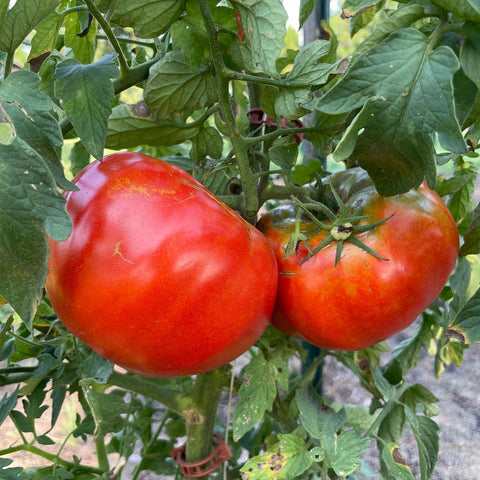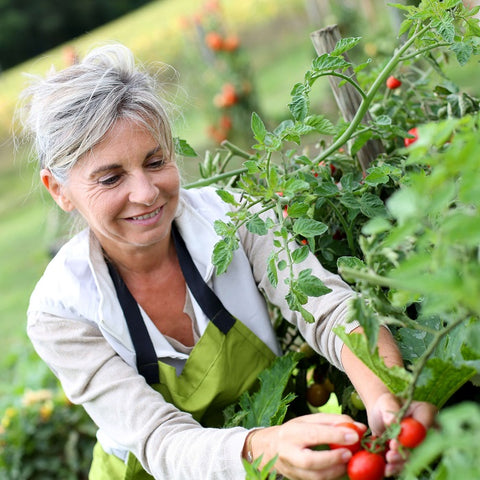In the summer garden bed, when the sun is shining and the breeze is blowing, the tomato plant shows its life force and vitality. They stand tall and luxuriant, dotted with bright red fruits, like a poetic plant paradise. In this season, we search for the secret of high yield, eager to connect the summer sun with the full harvest. Discover how to grow rich tomatoes in this garden bed that will delight the taste buds and infuse the heart with natural beauty.The following content also has some reference value for raised garden beds.

- Soil preparation:
Choose soil that is rich in organic matter to provide nutrients needed by plants and maintain moisture. Before sowing, add rotting compost or decaying animal waste to the soil to improve soil structure and retain moisture.
- Planting location:
Make sure the tomato plant gets plenty of sunlight. Choose a location that receives at least 6 to 8 hours of direct sunlight per day. Sunlight is a key factor in promoting plant growth and fruit ripening.
- Appropriate spacing:
Maintain proper plant spacing when planting seeds. Nightshade plants need enough space to grow and develop. Generally, tomato plants should be kept 2 to 3 feet apart from each other.
- Watering management:
Keep the soil moist, but avoid over-watering. In the summer, hot weather can cause the soil to dry out quickly, so check the soil moisture frequently and make sure to water the plants properly when they need it. Avoid pouring water directly on the leaves to reduce the spread of germs.
- Nutrition supply:
Tomato plants have higher nutrient requirements. Add organic fertilizer to the soil before sowing, and regularly apply appropriate amounts of nutrients such as nitrogen, phosphorus, and potassium. Organic or liquid fertilizers can be used, depending on the growth stage of the plant.
- Pruning and support:
Prune and support in time to ensure that the plant gets adequate air circulation and sunlight. Cut off excess lateral branches and leaves so that the plant's energy can be focused on fruit growth. Use support structures such as cages, braces or ropes to prevent the plant from falling over.
- Insect and disease prevention:
Inspect tomato plants regularly for signs of pests or disease. Use organic pest control methods, such as hand-trapping pests and spraying environmentally friendly pesticides, to protect plant health.
- Pick in time:
Picking ripe tomato fruit regularly will stimulate the plant to continue producing more fruit. Ripe tomato fruit should have a certain color, depending on the variety, can be red, yellow or other colors. Do not wait for the fruit to overripe, so as not to cause rot and waste.

- Temperature and risk control system:
High summer temperatures can have a negative effect on tomato plants. In hot weather, consider using a sunshade net or shade cloth to reduce thermal radiation to your plants. At the same time, maintain good ventilation, use natural wind or fans to reduce the temperature and reduce the pressure of plants under heat.
- Regular soil loosening:
Regular soil loosening can improve soil aeration and water permeability, and promote root growth and development. Use a hoe or rake to loosen the soil gently, but be careful not to damage the roots of the plant.
- Prevent the spread of germs:
The tomato plant is susceptible to a number of infections such as phytophthora infestation and bacterial spot disease. Inspect the plant regularly and treat the affected parts promptly to prevent the spread of the bacteria to other parts. Use appropriate fungicides or organic control methods to control the disease.
- Pay attention to rest:
Tomato plants also need time to rest and recover. If multiple batches of tomatoes are planted in a season in a row, it can cause plant fatigue and lower yields. At the end of the season, give the plants enough time to rest before starting a new crop.
- Perform proper fruit thinning:
Tomato plants usually produce lots of flowers and small fruits, but not all of the fruits will be able to fully develop into large, healthy tomatoes. Leaving too much fruit on the plant can result in an uneven distribution of resources, which can affect overall yield and quality. Therefore, regular thinning is needed to remove small, misshapened fruit or overly dense fruit so that the plant can focus on developing larger, healthier fruit.
- Use organic mulch:
Covering the surface of the soil can help maintain soil moisture, control weed growth, and reduce water evaporation. You can use organic mulch such as hay, sawdust or organic film to cover the surface of the soil. This not only helps maintain soil temperature and moisture, but also reduces competition from weeds for tomato plants, providing a more stable growing environment.
- Master proper harvesting techniques:
Proper picking techniques can help you get more tomatoes and maintain their quality. Use scissors or pruning tools to carefully cut or twist the fruit to avoid overpulling or damaging the plant. In addition, pick in the morning or evening, when the temperature is lower, the tomato taste and storage time is better.
- Check the health of the plant regularly:
Summer heat and humidity can cause tomato plants to be attacked by pests and diseases. Inspect the leaves, stems, and fruits of the plant regularly, looking for any signs of abnormality, such as yellowing, spots, and rot. If pest and disease problems are identified, take appropriate control measures immediately, such as manual removal of infected parts, use of organic pesticides or biological control methods.
- Pay attention to proper harvesting and storage:
Once the tomatoes have reached the right ripeness, harvest them in time. Gently hold the fruit, rotate and remove with ease. Ripe tomatoes can be stored in a cool, ventilated place, away from direct sunlight. If you have big

- Planting:
In order to extend the yield of tomatoes, continuous sowing can be done. Start planting in early spring or early summer, then plant a new batch of seedlings every few weeks. This ensures that new tomato plants ripen throughout the summer and early fall, increasing production.
- Pollination promotion:
Tomatoes are self-pollinating plants, but under high temperatures and humidity, pollen may stick to the corolla tube, causing pollination to be blocked. You can use manual pollination to promote pollen transfer. Use a cotton swab or small brush to gently touch the center of the flower to transfer pollen to other flowers and help promote pollination and fruit development.
- Pay attention to proper pest control:
Prevention is better than cure, and regular spraying of organic pesticides or biological control measures can help control tomato pests and diseases. At the same time, pay attention to maintaining hygiene around the plant and remove fallen leaves and discarded fruits to reduce the breeding of germs and pests.
- Choose varieties suitable for summer planting:
Different tomato varieties have different adaptability and heat resistance. When planting in summer, selecting varieties with higher heat resistance and disease resistance and insect resistance can improve the growth and yield of tomato plants.

Keep in mind that each garden has its own unique environment and conditions, so when growing tomatoes, you also need to adapt and experiment according to the actual situation. Try different methods and techniques to see how the plant reacts and make adjustments based on the observations. May you have a good harvest of tomatoes in summer!









